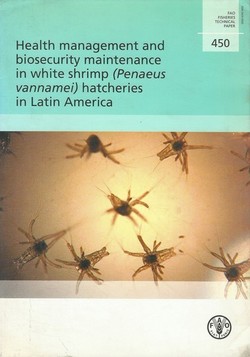Health management and biosecurity maintenance in white shrimp (Penaeus Vannamei) hatcheries in Latin America
By
Inland Water Resources and Aquaculture Service
Introduction
Disease has become a major constraint to shrimp aquaculture in Latin America. Especially since the outbreak of white spot disease (caused by the white spot syndrome virus, WSSV), shrimp production has decreased significantly in many countries and farmers are facing serious difficulties in continuing production. The resulting economic losses and their impacts are now significantly affecting national economies and the livelihoods of poorer sectors. For example, the shrimp exports from Ecuador in December 1999 fell to below 1985 levels. Provision of assistance for combating this situation is considered highly appropriate and timely. Such assistance will help secure shrimp aquaculture development, national income through trade (both local and international), and livelihoods of farmers and other service providers.
When the patterns of spread of diseases and pathogens of shrimp are examined, especially those for viral pathogens, there is convincing evidence that most major disease outbreaks are associated with the movement of live shrimp (broodstock, nauplii and postlarvae (PL)). It is important to remain very cautious over the international or regional movement of live shrimp stocks bound for aquaculture. This precaution applies even to domesticated stocks and to a single shrimp species cultivated in different places. However, movements should be permitted when proper quarantine and screening procedures have been applied.
Our understanding of the avenues and options for controlling shrimp diseases, especially WSSV, has improved over the past few years, mainly through the experiences gained in Asia and in Latin America. The ultimate solution for combating shrimp disease problems is to culture certified, domesticated stocks that are free of specific pathogens on nutritious, dry feeds in biosecure ponds under conditions that are nonstressful to the shrimp. This should be the ultimate goal for the shrimp industry.
With respect to stress, while it is impossible to control weather, we do have the ability to control many important variables, such as pond carrying capacity, feed inputs and water exchange. At present, dry feeds appear to be adequate, although there is obviously still room for improvement in their quality. The biggest potentially controllable problems that farmers currently face are uncertainty regarding the quality of postlarvae used in culture, and the lack of biosecurity of the pond environment from the entry of pathogens and their carriers.
The simplest way to solve the postlarval quality problem is to change from the use of postlarvae derived from captured broodstock to those derived from domesticated stocks. However, this practice requires considerable research effort and field-testing, and is still in its infancy. At least we can try to ensure biosecurity in ponds through appropriate screening of postlarvae for important pathogens prior to stocking. The procedures for screening postlarvae for important pathogens (predominantly WSSV) are known; however, additional training, capacity building, and upgrading of hatcheries and diagnostic centres are necessary.
Currently, harmonized technical standards for the hatchery production of postlarvae are lacking. It is imperative that such technical standards be developed, standardized, validated, and agreed upon by the hatchery producers, both nationally and internationally.
Contents
1 – Introduction
2 – The contribution of marine shrimp to global aquaculture production
3 – Requirements for effective hatchery production
4 – The pre-spawning process
5 – The post-spawning process
6 – References
*** For more please visit the library ***
Prep. / Ayman Ashry
Manage. / Mona Mahmoud




ساحة النقاش